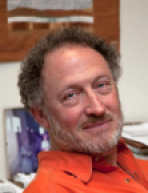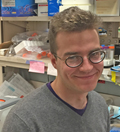


Director, Medical Scientist Training Program
Fellow of the American Association for the Advancement of Science (AAAS)
Association of American Physicians (AAP)
Postdoctoral fellowship, University of California at San Francisco
M.D., Ph.D., University of Pennsylvania School of Medicine
B.S. with Distinction, High Honors in Chemistry and in Cellular & Molecular Biology, University of Michigan
The Frohman laboratory cloned and has been exploring translational roles for the mammalian family of lipid-signaling Phospholipase D genes for the two decades. PLD superfamily members are involved in many physiological and pathophysiological settings including immune defenses, cancer, neurodegenerative disease, diabetes, cardiovascular disease, and fertility. Among other approaches, we have recently been generating and publishing findings with mice lacking each of the PLD isoforms, and have uncovered a number of fascinating stories with human health relevance. Recent work has included exploring the potential of using a Phospholipase D small molecule inhibitor as a therapeutic in stroke, cardiovascular disease and cancer progression settings. Cell biological processes of particular interest include mitochondrial fusion and fission, subcellular trafficking of membrane vesicles during signaling activated exocytosis and endocytosis, viral trafficking through the Golgi complex, integrin activation, and receptor signaling.
Michael Frohman undertook training in a variety of disciplines including biochemistry, immunology, and developmental biology. During his postdoctoral fellowship, he developed the molecular biological technique known as “5’ RACE” which since has seen wide use, first in cDNA cloning and now in the cataloging of endogenous RNAi. The Frohman lab cloned the mammalian family of PLD isoforms in the mid-to-late ‘90s, and has since been exploring their function in numerous disease settings. Alumni of the Frohman lab have faculty positions in South Korea, Russia, and the USA.
Mallipattu et al. (2015) Krüppel-like factor 6 regulates mitochondrial function in the kidney. J. Clinical Investigation, in press.
Akiyama et al. (2014) Trans-regulation of oligodendrocyte myelination by neurons through small GTPase Arf6-regulated secretion of fibroblast growth factor-2. Nature Communications, 5:4744.
Teng et a. (2014) Phospholipase D1 facilitates second phase myoblast fusion and skeletal muscle regeneration. Molecular Biology of the Cell, in press.
Baba et al. (2014) Phosphatidic acid (PA)-preferring phospholipase A1 regulates mitochondrial dynamics. J. Biol. Chem., 289:11497-511.
Stegner et al. (2013) Pharmacological inhibition of phospholipase D protects mice from occlusive thrombus formation and ischemic stroke. Arteriosclerosis, Thrombosis, and Vascular Biology, 33:2212-7.
Altshuller, A., Gao, G., and Frohman, M.A. (2013) A C-terminal transmembrane anchor targets the nuage-localized spermatogenic protein Gasz to the mitochondrial surface. ICRN Cell Biology, pii: 707930.
Ali et al. (2013) Deficiencies of the lipid-signaling enzymes phospholipase D1 and D2 alter cytoskeletal organization, macrophage phagocytosis, and cytokine-stimulated neutrophil recruitment. PLoS One, 8.e55325.
Li et al. (2013) High throughput sequencing analysis of natural regulatory and conventional T cell receptor repertoires during human H1N1 challenge. Nature Communications, 4:2333.
Chen et al. (2012) Key roles for the lipid signaling enzyme phospholipase D1 in the tumor microenvironment during tumor angiogenesis and metastasis. Science Signaling, 5:ra79.
Osisami, M., Ali, W. and Frohman, M.A. A role for Phospholipase D3 in myotube formation. (2012). PLoS One, 7(3): e33341.
Yoon, M.-S., Du, G., Backer, J.M., Frohman, M.A. and Chen J. (2011) hVps34 activates PLD1 in an amino acid-sensing mTORC1 pathway. J. Cell Biology, 195:435-47.
Huang, H., Gao, Q. Peng, X.X., Choi, S.-Y., Sarma, K., Ren, H., Morris, A.J., and Frohman, M.A. (2011) piRNA-associated germline nuage formation and spermatogenesis require MitoPLD pro-fusogenic mitochondrial-surface lipid signaling. Developmental Cell, 20:376-387.
Huang, P., Yeku, O., Zong, H., Tsang, P., Su, W., Xu, X., Teng, S., Osisami, M., Kanaho, Y., Pessin, J.E., and Frohman, M.A. (2011) PI4P5-Kinase a deficiency alters dynamics of glucose-stimulated insulin release and protects against type 2 diabetes and obesity in mice. Diabetes,60:454-63.
Elvers et al., (2010) Impaired integrin aIIbb3 activation and shear-dependent thrombus formation in mice lacking phospholipase D1. Science Signaling, 3:1-10.
Tsukahara et al. (2010) The novel second messenger Cyclic PA Negatively Regulates the Nuclear Hormone Receptor PPARγ. Molecular Cell, 39:421-32.
Dall’Armi, C., Hurtado-Lorenzo, A., Voronov, S.V., Yeku, O., Frohman, M.A., and Di Paolo, G. (2010) The Phospholipase D1 Pathway Modulates Macroautophagy. Nature Communications, 1:142-152.
Scotto-Lavino, E., Garcia-Diaz, M., Du, G., and Frohman, M.A. (2010) The basis for the isoform-specific interaction of Myosin Phosphatase subunits PP1c b and MYPT1. J. Biol. Chem., 285:6419-24.
Huang, H., Choi, S.-Y., and Frohman, M.A. (2010) A Quantitative Assay for Mitochondrial Fusion using Renilla Luciferase Complementation. Mitochondrion, 10:559-66.
Nishikimi et al. (2009) Sequential Regulation of DOCK2 Dynamics by Two Phospholipids during Neutrophil Chemotaxis. Science, 324:384-7.
Du, G. and Frohman, M.A. (2009) A lipid-signaled myosin phosphatase surge disperses cortical contractile force early in cell spreading. Mol. Biol. Cell, 1:200-8.
Su, W., Yeku, O., Olepu, S., Genna, A., Park, J.-S., Ren, H., Du, G., Gelb, M.H., Morris, A.J., and Frohman, M.A. (2009) FIPI, a PLD pharmacological inhibitor that alters cell spreading and inhibits chemotaxis. Mol. Pharm. 75:437-46.
Yang, J.-S. et al. (2008) COPI vesicle fission: a role for phosphatidic acid and insight into Golgi maintenance. Nature Cell Biol., 10:1146-53.
Scotto-Lavino,E, Du,G, and Frohman,MA (2007) 5’ End cDNA Amplification using Classic RACE. Nature Protocols, 1:2555-2562.
Zhao, C., Du, G., Skowronek, K., Frohman, M.A., and Bar-Sagi, D. (2007) Phospholipase D2-generated PA couples EGFR stimulation to Ras activation by Sos. Nature Cell Biol, 9:707-12.
Choi, S.-Y., Huang, P., Jenkins, G.M., Chan, D.C., Schiller, J., and Frohman, M.A. (2006) A common signaling lipid requirement for Mfn-mediated mitochondrial fusion and SNARE-regulated exocytosis. Nature Cell Biol., 8:1255-62.
LaLonde, M.M., Janssens, H., Rosenbaum, E., Choi, S.-Y., Gergen, J.P., Colley, N.J., Stark, W.S., and Frohman, M.A. (2005) Regulation of phototransduction responsiveness and retinal degeneration by a phospholipase D–generated signaling lipid. J. Cell Biol. 169:471-9.
Sasaki, J. et al. (2005) The phosphatidylinositol 4-phosphate 5-kinase PIPKIa is a negative regulator of anaphylaxis and FceRI signaling. J. Exp. Med., 201:859-70.
Huang, P., Altshuller, Y.M., Hou, J.C., Pessin, J.E., and Frohman, M.A. (2005) Insulin-stimulated plasma membrane fusion of the Glut4 glucose transporter is regulated by PLD1. Mol. Biol. Cell, 16:2614–23.
Du, G., Huang, P., Liang, B.T. and. Frohman, M.A. (2004) PLD2 localizes to the plasma membrane and regulates AgntII receptor endocytosis. Mol. Biol. Cell, 15:1024-30.
Du, G, Altshuller, YM, Vitale, N, Huang, P, Morris, AJ, Bader, MF, and Frohman, MA (2003) Regulation of PLD subcellular cycling through coordination of multiple membrane association motifs. J. Cell Biol 62:305-15.
Vitale, N., Caumont, A.S., Chasserot-Golaz, S., Wu, S., Zhang, Y., Morris, A.M., Frohman, M.A. and Bader, M.F (2001) PLD1: a key factor for the exocytotic machinery in neuroendocrine cells. EMBO J., 20:2424-34.
Zhang, Y, Altshuller, Y.A., Hammond, S.A., Hayes, F., Morris, A.J., and Frohman, M.A. (1999) Loss of Receptor Regulation by a PLD1 mutant unresponsive to Protein Kinase C. EMBO J., 18:6339-6348.
Honda et al. (1999) Phosphatidylinositol 4-phosphate 5-kinasea is a Downstream Effector of the Small G Protein ARF6 in Membrane Ruffle Formation. Cell, 99:521–32.
Colley, W.C., Sung, T.-C., Roll, R., Jenco, J., Hammond, S.M., Altshuller, Y.M., Bar-Sagi, D., Morris, A.J., and Frohman, M.A. (1997) Phospholipase D2, a distinct phospholipase D isoform with novel regulatory properties that provokes cytoskeletal reorganization. Curr. Biol. 7:191-201.
Sung et al. (1997) Mutagenesis of Phospholipase D defines a superfamily including a trans-Golgi viral protein required for poxvirus pathogenicity. EMBO J. 16:4519-4530.
Chong et al. (1995) REST: A Mammalian Silencer Protein that Restricts Sodium Channel Gene Expression to Neurons. Cell 80:949-957.
Hammond, S.M., Altshuller, Y.M., Sung, T.-C., Rudge, S.A., Rose, K., Engebrecht, J., Morris, A.J, and Frohman, M.A. (1995) Human ARF-activated phosphatidylcholine-specific Phospholipase D Defines a New and Highly Conserved Gene Family. J. Biol. Chem. 270: 29640-43.
Frohman, M.A., Dush, M.K., and Martin, G.R. (1988). Rapid production of full-length cDNAs from rare transcripts by amplification using a single gene-specific oligonucleotide primer. PNAS 85:8998-9002.
Lab: 495 Center for Molecular Medicine
Phone: 631-632-1477
|
Yelena Altshuller |
|
|
Finly Philip, PhD |
|
|
Yi Zhang |
|
|
Rochelle Nelson Physiology Graduate student
|
|
|
Julie-ann Cavallo |
 |
|
Undergraduates: |
|
|
Elizabeth Ha |
 |
|
Jackie (Jai-Qi) Tang |
|
|
Danya Abedeen |
|
|
Obiora Egbo |
|
|
Sunny Cho |
|
|
Veevek Shah |
|
|
Mark Falko
|
 |
The Frohman Laboratory
| Research Interests | Selected Publications | CMM |
| Molecular Cloning Facility | Current Lab Members | Former Lab Members |
Regulation of exocytosis, cell shape, and mitochondrial fusion by lipid signaling pathways
Our laboratory examines lipid signals that alter cell morphology, regulate mitochondrial fusion, and trigger subcellular trafficking of membrane vesicles during regulated exocytosis and endocytosis. Disease-related topics include neurodegenerative disease (Charcot-Marie Tooth syndrome), diabetes, cancer, and impaired phagocytic immune responses to pathogens.
The specific topic constitutes study of signaling pathways mediated by members of the superfamiles of enzymes known as Phospholipase D (PLD) and PI4P Kinase. Classic PLD is activated by a wide variety of agonists that signal through G-protein coupled or tyrosine kinase receptors. PLD has varied cellular roles including facilitating membrane vesicle trafficking and fusion of the vesicles into the plasma membrane during regulated exocytosis, and reorganizing the actin cytoskeleton. We are currently investigating roles for PLD and PI4P lipid kinase in actin cytoskeleton reorganization, myoblast differentiation and fusion, Glut-4 glucose transporter translocation, phagocytosis, and regulated exocytosis (insulin and histamine release). In addition, we are exploring a novel member of the PLD superfamily that localizes to mitochondria and regulates fusion, and the mechanisms through which diminished rates of fusion cause neurodegenerative disease.
| Title | Name | Degree | Project | Phone# |
| Principal Investigator | Michael Frohman |
MD, PhD, U. Penn. | Making lab members feel happy about working hard | |
| Sr. Research Support Specialist |
|
MS, College of Chemistry & Pharmacology, St. Petersburg, Russia |
Lab manager and Supervisor, Molecular Cloning Facility
|
2-1477 |
| Administrative Assistant |
|
BA, SUNY at Stony Brook |
Administration | 631-632-1634 |
|
Postdoctoral Fellow |
Phyllis Tsang | PhD, Univ.of Hong Kong | MRI imaging of pancreatic beta-cells | |
| Postdoctoral Fellow | Xiao Xue (Sherry) Peng | Ph.D., Shanghai U. | Structural biology of MitoPLD | |
| Postdoctoral Fellow | Qin (Grace) Chen | Shanghai Institute of Materia Medica | Functional roles for PLD | |
| Postdoctoral Fellow | Qun Gao | Ph.D., New York Medical College | Imaging Mitochondrial fusion | |
|
Graduate Student |
|
BS, SUNY Stony Brook | Functional analysis of PLD superfamily proteins | |
|
Postdoctoral Fellow
|
|
Ph.D., Stony Brook University | Phosphoinositides and phagocytosis; PLD inhibitor | |
| Graduate Student |
BS, Fudan Univ., Shanghai, P. R. of China |
Mitochondrial fusion | ||
| Graduate Student |
|
BS, Medgar Evers College | Mitochondrial fusion and disease | |
| Graduate Student |
|
B.S. SUNY Binghamton | PLD roles in phagocytosis | |
|
Graduate Student-mentor: Dr. Guangwei Du |
B.S. Stony Brook University | PIP Kinases and PA |
| Former Lab Members: | ||
| Past Title | Name | Current Position |
| Technician | Ritu Goyanka | Graduate Student, NYU |
| Wei Ao | Technician, SUNY Stony Brook | |
| Post-Docs | Olga E. Redina | Assoc.. Prof., U. Novosibirsk, Russia |
| Juan A. Crosby | Post-doc., UMDNJ, Newark, NJ | |
| Hilde Janssens | FlyMine Administrator, England | |
| Guangwei Du | Assistant Professor, University of Texas at Houston | |
| Gary Jenkins | ||
| Xiao Yu | ||
| Ping Huang | Instructor, Harvard University | |
| Grad. Students | William C. Colley | Post-doc., St. Judes Hospital, Memphis, TN |
| Tsung-Chang Sung | Post-doc., The Salk Institute | |
| Yue Zhang | Post-doc., SUNY Stony Brook | |
| Suyong Yun | Clinical pharmacology and discovery medicine investigator | |
| Si Wu | Graduate Student, Computer Science, SUNY Stony Brook | |
| Danxia Ke | Memorial Sloan-Kettering Cancer Center, New York, NY | |
| Nianzhou Xiao | Medical Residency | |
| Margie LaLonde | Resident, Fast-track program in Psychiatry, Columbia University | |
| Seok-Yong Choi | Assistant Professor Chonam University, South Korea | |
| Elizabeth Scotto-Lavino | Post-doc, BNL |
Huang, H., Gao, Q. Peng, X.X., Choi, S.-Y., Sarma, K., Ren, H., Morris, A.J., and Frohman, M.A. (2011) piRNA-associated germline nuage formation and spermatogenesis require MitoPLD pro-fusogenic mitochondrial-surface lipid signaling. Developmental Cell, 20:376-387.
Huang, P., Yeku, O., Zong, H., Tsang, P., Su, W., Xu, X., Teng, S., Osisami, M., Kanaho, Y., Pessin, J.E., and Frohman, M.A. (2011) PI4P5-Kinase a deficiency alters dynamics of glucose-stimulated insulin release and protects against type 2 diabetes and obesity in mice. Diabetes,60:454-63.
Elvers et al., (2010) Impaired integrin aIIbb3 activation and shear-dependent thrombus formation in mice lacking phospholipase D1. Science Signaling, 3:1-10.
Tsukahara et al. (2010) The novel second messenger Cyclic PA Negatively Regulates the Nuclear Hormone Receptor PPARγ. Molecular Cell, 39:421-32.
Dall’Armi, C., Hurtado-Lorenzo, A., Voronov, S.V., Yeku, O., Frohman, M.A., and Di Paolo, G. (2010) The Phospholipase D1 Pathway Modulates Macroautophagy. Nature Communications, 1:142-152.
Scotto-Lavino, E., Garcia-Diaz, M., Du, G., and Frohman, M.A. (2010) The basis for the isoform-specific interaction of Myosin Phosphatase subunits PP1c b and MYPT1. J. Biol. Chem., 285:6419-24.
Huang, H., Choi, S.-Y., and Frohman, M.A. (2010) A Quantitative Assay for Mitochondrial Fusion using Renilla Luciferase Complementation. Mitochondrion, 10:559-66.
Nishikimi et al. (2009) Sequential Regulation of DOCK2 Dynamics by Two Phospholipids during Neutrophil Chemotaxis. Science, 324:384-7.
Du, G. and Frohman, M.A. (2009) A lipid-signaled myosin phosphatase surge disperses cortical contractile force early in cell spreading. Mol. Biol. Cell, 1:200-8.
Su, W., Yeku, O., Olepu, S., Genna, A., Park, J.-S., Ren, H., Du, G., Gelb, M.H., Morris, A.J., and Frohman, M.A. (2009) FIPI, a PLD pharmacological inhibitor that alters cell spreading and inhibits chemotaxis. Mol. Pharm. 75:437-46.
Yang, J.-S. et al. (2008) COPI vesicle fission: a role for phosphatidic acid and insight into Golgi maintenance. Nature Cell Biol., 10:1146-53.
Scotto-Lavino,E, Du,G, and Frohman,MA (2007) 5’ End cDNA Amplification using Classic RACE. Nature Protocols, 1:2555-2562.
Zhao, C., Du, G., Skowronek, K., Frohman, M.A., and Bar-Sagi, D. (2007) Phospholipase D2-generated PA couples EGFR stimulation to Ras activation by Sos. Nature Cell Biol, 9:707-12.
Choi, S.-Y., Huang, P., Jenkins, G.M., Chan, D.C., Schiller, J., and Frohman, M.A. (2006) A common signaling lipid requirement for Mfn-mediated mitochondrial fusion and SNARE-regulated exocytosis. Nature Cell Biol., 8:1255-62.
LaLonde, M.M., Janssens, H., Rosenbaum, E., Choi, S.-Y., Gergen, J.P., Colley, N.J., Stark, W.S., and Frohman, M.A. (2005) Regulation of phototransduction responsiveness and retinal degeneration by a phospholipase D–generated signaling lipid. J. Cell Biol. 169:471-9.
Sasaki, J. et al. (2005) The phosphatidylinositol 4-phosphate 5-kinase PIPKIa is a negative regulator of anaphylaxis and FceRI signaling. J. Exp. Med., 201:859-70.
Huang, P., Altshuller, Y.M., Hou, J.C., Pessin, J.E., and Frohman, M.A. (2005) Insulin-stimulated plasma membrane fusion of the Glut4 glucose transporter is regulated by PLD1. Mol. Biol. Cell, 16:2614–23.
Du, G., Huang, P., Liang, B.T. and. Frohman, M.A. (2004) PLD2 localizes to the plasma membrane and regulates AgntII receptor endocytosis. Mol. Biol. Cell, 15:1024-30.
Du, G, Altshuller, YM, Vitale, N, Huang, P, Morris, AJ, Bader, MF, and Frohman, MA (2003) Regulation of PLD subcellular cycling through coordination of multiple membrane association motifs. J. Cell Biol 62:305-15.
Vitale, N., Caumont, A.S., Chasserot-Golaz, S., Wu, S., Zhang, Y., Morris, A.M., Frohman, M.A. and Bader, M.F (2001) PLD1: a key factor for the exocytotic machinery in neuroendocrine cells. EMBO J., 20:2424-34.
Zhang, Y, Altshuller, Y.A., Hammond, S.A., Hayes, F., Morris, A.J., and Frohman, M.A. (1999) Loss of Receptor Regulation by a PLD1 mutant unresponsive to Protein Kinase C. EMBO J., 18:6339-6348.
Honda et al. (1999) Phosphatidylinositol 4-phosphate 5-kinasea is a Downstream Effector of the Small G Protein ARF6 in Membrane Ruffle Formation. Cell, 99:521–32.
Colley, W.C., Sung, T.-C., Roll, R., Jenco, J., Hammond, S.M., Altshuller, Y.M., Bar-Sagi, D., Morris, A.J., and Frohman, M.A. (1997) Phospholipase D2, a distinct phospholipase D isoform with novel regulatory properties that provokes cytoskeletal reorganization. Curr. Biol. 7:191-201.
Sung et al. (1997) Mutagenesis of Phospholipase D defines a superfamily including a trans-Golgi viral protein required for poxvirus pathogenicity. EMBO J. 16:4519-4530.
Chong et al. (1995) REST: A Mammalian Silencer Protein that Restricts Sodium Channel Gene Expression to Neurons. Cell 80:949-957.
Hammond, S.M., Altshuller, Y.M., Sung, T.-C., Rudge, S.A., Rose, K., Engebrecht, J., Morris, A.J, and Frohman, M.A. (1995) Human ARF-activated phosphatidylcholine-specific Phospholipase D Defines a New and Highly Conserved Gene Family. J. Biol. Chem. 270: 29640-43.
Frohman, M.A., Dush, M.K., and Martin, G.R. (1988). Rapid production of full-length cDNAs from rare transcripts by amplification using a single gene-specific oligonucleotide primer. PNAS 85:8998-9002.
Research queries regarding billing, ordering, and shipping should be addressed to Jamie Hooper (Jamie.Hooper@stonybrook.edu), CMM 466, 631-632-1634 (phone), 631-632-1695 (fax).
Administrative or Personnel queries should be addressed to the Pharmacology
Department Administrator, Katie Houghton (katie.houghton@stonybrook.edu),
BST8-140, 631-444-3050 (phone).
Shipping: Frohman Lab, 495 CMM, Stony Brook University, Stony Brook, NY, 11794-5140